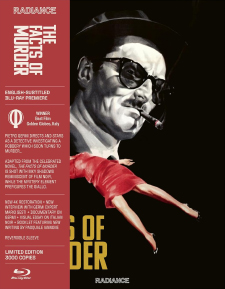Facts of Murder, The (Blu-ray Review)

Director
Pietro GermiRelease Date(s)
1959 (January 2, 2024)Studio(s)
Riama Film/Cineriz (Radiance Films)- Film/Program Grade: A-
- Video Grade: A
- Audio Grade: A-
- Extras Grade: A-
Review
Screenwriter-director-actor Pietro Germi is undoubtedly best remembered for Divorce Italian Style (1961), for which Germi was nominated for an Oscar as Best Director and won for Best Original Screenplay. The Facts of Murder (Un maledetto imbroglio, 1959) is, arguably, even better. Filmed in black-and-white for standard 1.37:1 projection and restored in 4K from the original camera negative by Cineteca di Bologna, this is one of the best video transfers of a B&W, standard-frame film I’ve ever seen, a real pleasure to watch.
The film also stars Germi as police Inspector Ingravallo, first called to the scene of a break-in at an apartment where some family jewels have been stolen. The victim, a middle-aged homosexual, is reluctant to press charges for the accompanying press coverage it would bring, but Ingravallo grills suspect Diomede (Nino Castelnuovo, of The Umbrellas of Cherbourg), fiancé of Assuntina (Claudia Cardinale), the maid of wealthy Liliana Banducci (Elornora Rossi Drago), who lives next-door. Diomede reluctantly produces an alibi—he had been whoring himself out as a gigolo to a rich American tourist while the crime was taking place.
Soon after, Valdarena (Franco Fabrizi), a quack “doctor” leaching money off cousin Liliana, enters her apartment to find her dead on the floor, stabbed to death. Ingravallo and his flying squad team wonder whether the break-in and murder are connected. Valdarena, clearly, is a smooth-talking sleazeball, but what about Liliana’s semi-estranged husband, Remo Banducci (Claudio Gora), who claims to have been out of town when the murder occurred, though there are holes in his alibi? And why did Liliana, a woman in her late-30s, not only prepare a will but changed it just a week prior to her murder?
Roberto Curti’s detailed booklet essay describes The Facts of Murder as a landmark genre hybrid, combining elements of Hollywood cinema (particularly film noir) with Italian neorealism, newfound postwar freedoms, and other influences. He notes the film has been inaccurately described by its makers as “the first Italian giallo” and by reviewers as “Italy’s first poliziottesco [crime film].” Neither may be true, but Germi’s film clearly is an antecedent of much of what would follow in those genres. Several steps ahead of Hollywood’s own genre films, it more explicitly alludes to prostitution (male and female), homosexuality, grooming and sexual relationships between adults and minors, while also acknowledging the subtle hierarchy of Italy’s middle- and lower classes. It’s more akin to Welles’ Touch of Evil than the usual studio noir from the period.
On one hand, The Facts of Murder presents an engrossing mystery but, more than that, the lasting impression it leaves is of its colorful characters, characters that seem to have existed before the film starts and who’ll be around long after the story has ended. I was particularly drawn to one of Ingravallo’s lieutenants, Det. Saro (Saro Urzi), a fat, balding veteran cop who always seems to be stuffing his face with food whenever he has a chance, just as Ingravallo keeps calling his never-seen girlfriend whenever he has a moment. Saro and the other cops working under Ingravallo are individuals in Germi’s hands; some are more competent than others, good at some tasks but not others. Likewise, the various suspects (including many red herrings) are all fascinating, intriguing characters; even the locations, so evocative of their time and place, are visually interesting throughout.
The aforementioned video transfer of The Facts of Murder dazzles. For a film that so often crams a half-dozen or more characters into the frame, with settings so rich in details the film is like a veduta at times (particularly its opening and closing scenes), the black-and-white, 1.37:1 standard frame transfer maintains an impressive razor-sharpness, the kind of release that makes the need for a 4K player seem less urgent—Why spring for an upgrade when Blu-rays can look this good? The uncompressed LPCM 2.0 mono track (Italian only, with excellent English subtitles) is also well above average for what it is. Encoded for Regions “A” and “B.”
Supplements consist of a new, 47-minute interview with Germi scholar Mario Sesti; a 39-minute documentary from 1997 about Germi, featuring interviews with Cardinale, director Giuseppe Tornatore, and others; and a 19-minute visual essay by Paul A. J. Lewis about noir in Italian cinema.
An excellent film given a flawless video transfer, The Facts of Murder is highly recommended.
- Stuart Galbraith IV

